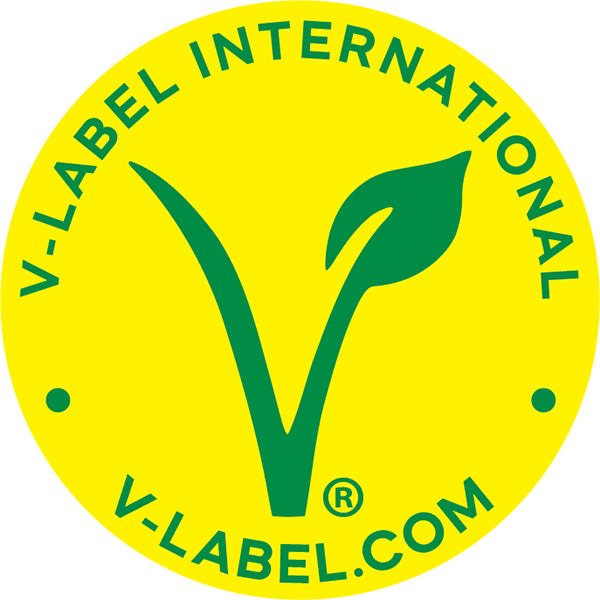Criteria for the V-Label
Definition of ‘vegan’
(1) Products are considered vegan if they are not of animal origin and, at no stage of production and processing, has use been made of or has the product been supplemented with:
- ingredients or components that are of animal origin (including additives, carriers, aromas, fragrances, flavorings, and enzymes), or
- processing aids that are of animal origin, or
- substances which are not additives but which are used in the same way and with the same purpose as processing aids in either processed or unprocessed form and which are of animal origin, or
- any ingredient or component animal based by nature even without involving animal sources (e.g., by precision fermentation).
This includes, especially but not exclusively:
- No meat or any other slaughter products, (e.g. offal).
- No fish or any other marine animals.
- No eggs
- No honey
- No milk
- No wax from animals, including wool fat/lanoline, beeswax and shellac.
- No fur, no leather, no silk.
- No royal jelly.
- No coloring agents of animal origin.
- No substances bleached with animal charcoal.
- No substances which were clarified with animal substances such as gelatine or fish bladder.
- No substances manufactured, obtained, or produced from the above-mentioned substances.
Definition of ‘vegetarian’
(2) Products are considered vegetarian if they meet the requirements of paragraph (1), with the difference being that in their production, milk, colostrum, eggs, honey, beeswax, propolis or wool grease, including lanolin derived from the wool of living sheep, or their components or derivatives may be added or used.
This includes, especially but not exclusively:
- No meat or any other slaughter products, (e.g. offal).
- No fish or any other marine animals.
- No eggs from birds reared in cages (including ‘enriched cages’ and small group-housing systems)
- No eggs obtained by killing animals (e.g. caviar).
- No dairy products where animal rennet was used.
- No royal jelly.
- No coloring agents obtained by killing animals (e.g. real carmine).
- No aromas, fragrances, or flavorings of animal origin, except if the substance corresponds to the definition in paragraph (2).
- No substances bleached with animal charcoal.
- No carrier substances of animal origin, except if the substance corresponds to the definition in paragraph (2).
- No substances clarified with animal substances such as gelatine or fish bladder, except if the substance corresponds to the definition in paragraph (2).
- No substances manufactured, obtained, or produced from the above-mentioned substances.
Culture media
The aforementioned vegan and vegetarian definitions refer to all stages of production and processing and thus include the processes of biotechnological production of ingredients or substances. Biotechnological methods are methods in which bacteria, fungi, algae, eukaryotic unicellular organisms, and/or cell cultures for the production and/or modification of the ingredients are deliberately added. For example, the last-used culture media, fermenter substrates, and/or carrier materials in the production of ingredients or substances which are part of the final product must also fulfil the aforementioned criteria for vegan ingredients or substances and vegetarian ingredients or substances respectively.
Guidelines for unintended traces
All stages of production, processing, and distribution should be designed in a way that there is no unintended presence of non-vegan or non-vegetarian substances respectively. The unintended presence of non-vegan or non-vegetarian substances should be less than 0.1 % (1g/kg) in the final product. If the benchmark of 0.1 % is exceeded, the producer is obliged to improve all stages of production, processing and distribution. If optimization is not possible, the producer has to state reasons for this. Provided that the producer has made all the arrangements to avoid contamination with non-vegan or non-vegetarian substances, a deviation from the benchmark of 0.1 % does not automatically result in an exclusion of the ’vegan’ or ’vegetarian’ V-Label.
Genetically modified organisms (GMOs)
Products that require GMO-labeling according to applicable laws cannot be licensed with the V-Label.
Animal testing
Tests of any kind on animals must not be or have been carried out for the end product. Also, animal testing of individual ingredients, auxiliaries, and other substances used for processing are not allowed if they are carried out specifically for the end product. This applies to the licensee as well as the producer (if not the same as the licensee) directly and on behalf of the same; for example, for the purpose of research, development, and/or production, including animal testing under the guidance of government agencies at home and abroad. Exceptions are permitted only if the main benefit of the product to be tested is for the species on which the product is being tested and the tests, similar to clinical tests on humans, do not affect the health and well-being of the animal. For example, it is permissible to feed vegetarian dog food over a longer period of time to domestic dogs (of dog owners voluntarily willing to participate in the study) and to regularly check the health of the dog by a veterinarian during this period.
Definition of ‘animal’
The V-Label defines animals as multicellular eukaryotic organisms (organisms whose cells have a nucleus enclosed within membranes) that do not derive their metabolic energy from sunlight like plants do, need oxygen to breathe and are not fungi. This includes all vertebrates and invertebrates.
Audits
Licensees accept that regular audits commissioned by the licensors will be carried out.

 Argentina
Argentina België (NL)
België (NL) Bosna i Hercegovina
Bosna i Hercegovina Brasil
Brasil Chile
Chile 中国
中国 Česká republika
Česká republika Colombia
Colombia Costa Rica
Costa Rica Danmark
Danmark Deutschland
Deutschland Ecuador
Ecuador España
España France
France Ελληνικά
Ελληνικά Hrvatska
Hrvatska Italia
Italia Lietuvių
Lietuvių 한국어
한국어 Magyar
Magyar Lebanon (EN)
Lebanon (EN) Melayu
Melayu Mexico
Mexico Nederland
Nederland Nigeria
Nigeria Norge
Norge Österreich
Österreich Perú
Perú Polski
Polski Português
Português Română
Română Русский
Русский Slovenčina
Slovenčina Türkçe
Türkçe South Africa
South Africa Suomi
Suomi Svenska
Svenska Schweiz
Schweiz Українська
Українська الامارات العربية المتحدة
الامارات العربية المتحدة Tiếng Việt
Tiếng Việt